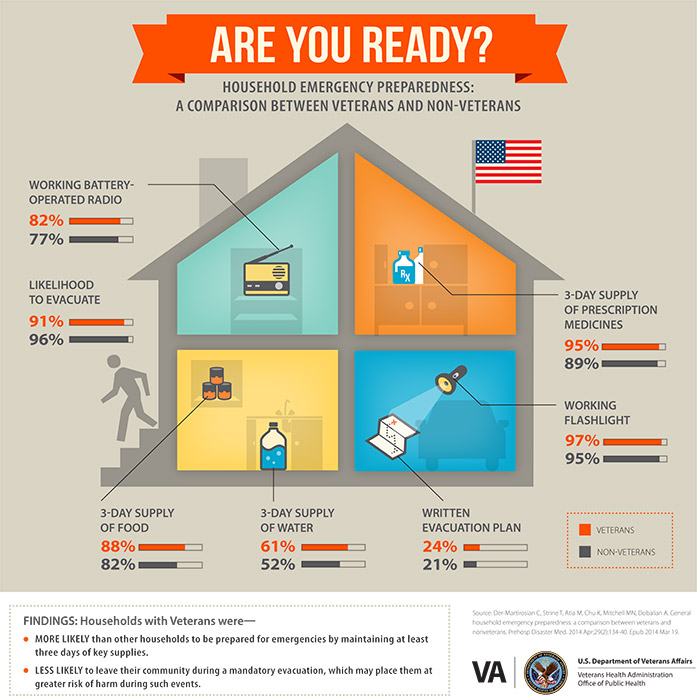Household Emergency Preparedness
Veterans are at risk during public health emergencies because they are more likely than the general population to have multiple health conditions.
Be ready
Visit www.ready.gov for help to:
Research shows need for preparedness
A study compares levels of household emergency preparedness between Veterans and non-Veterans by focusing on seven measures: 3-day supply of food, water, prescription medications, a battery-operated radio and flashlight, a written evacuation plan, and willingness to leave their community during a mandatory evacuation.

Text version of infographic
Are you ready? Household emergency preparedness: A comparison between Veterans and non-veterans
- Likelihood to evacuate: 91% Veterans, 96% non-veterans
- Working battery-operated radio: 82% Veterans, 77% non-veterans
- 3-day supply of prescription medicines: 95% Veterans, 89% non-veterans
- Working flashlight: 97% Veterans, 95% non-veterans
- Written evacuation plan: 24% Veterans, 21% non-veterans
- 3-day supply of water: 61% Veterans, 52% non-veterans
- 3-day supply of food: 88% Veterans, 82% non-veterans
Findings: Households with Veterans were
- More likely than other households to be prepared for emergencies by maintaining at least three days of key supplies.
- Less likely to leave their community during a mandatory evacuation, which may place them at greater risk of harm during such events.
Source: Der-Martirosian C, Strine T, Atia M, Chu K, Mitchell MN, Dobalian A. General household emergency preparedness: a comparison between veterans and nonveterans. Prehosp Disaster Med. 2014 Apr;29(2):134-40. Epub 2014 Mar 19.
Source
The study used data from the 2006 through 2010 Behavioral Risk Factor Surveillance System, a state representative, random sample of adults aged 18 and older living in 14 states. The Veterans Emergency Management Evaluation Center (VEMEC) conducted the study in collaboration with the Center for Disease Prevention and Control. Read the study abstract.
VEMEC is a leading research and evaluation center for the study and development of emergency management practices funded by VA.



















